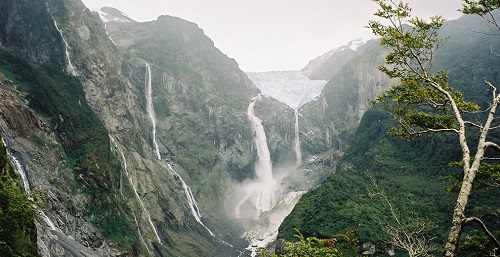Glacier

Glacier cover more than one tenth of the Earth’s surface. Glaciers are enormous masses of compressed ice and form in cold zones, at the North and South Poles and on high mountains, where the quantity of snow which accumulates in a year is more than the amount which melts in the heat from the Sun.
Mountain glaciers can cause great erosion. Their slow movements down towards the base of the mountain claws away at the rocks and when they meet cracks, they form deep crevasses, hollowing out wide valleys and depositing debris downhill.
A glacier is a persistent body of dense ice that is constantly moving under its own weight; it forms where the accumulation of snow exceeds its melting and sublimation over many years, often centuries.
Glaciers slowly deform and flow due to stresses induced by their weight, creating various distinguishing features. They also abrade rock and debris from their substrate to create landforms such as cirques and moraines.
Glaciers form only on land and are distinct from the much thinner sea ice and lake ice.
Glacial ice is the largest reservoir of fresh water on Earth. Many glaciers from temperate, alpine and seasonal polar climates store water as ice during the colder seasons and release it later in the form of melt-water as warmer summer temperatures cause the glacier to melt, creating a water source that is especially important for plants, animals and human uses when other sources may be scant.
Within high altitude and Antarctic environments, the seasonal temperature difference is often not sufficient to release melt-water.

Glaciers are present on every continent and approximately fifty countries, excluding those that have glaciers only on distant subantarctic island territories. Extensive glaciers are found in Antarctica, Chile, Canada, Alaska, Greenland and Iceland.

Mountain glaciers are widespread, especially in the Andes, the Himalayas, the Rocky Mountains, the Caucasus, and the Alps.
Icebergs

Icebergs are fragments of the ice cap which break away from the glacier coast due to bombardment of sea waves. Icebergs can become transportable by the wind and the sea current. Some can take up to ten years to melt.
Interesting things about Glaciers
- Glaciers cover almost 14 million square kilometers of the Earth’s surface.
- The fastest moving ice is the Columbia Glacier in Alaska which moves about 20m per day.
- Alpine glaciers travel about 50m in one year.
- The widest Glacier 4780m is in the Antarctic.
- An alpine Glacier form in time scale which can be from 2 to 20 years.
- The longest iceberg is the Lambert-Fisher Ice passage in the Australian Antarctic which covers at least 700km.
